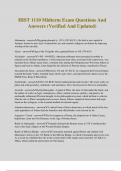College aantekeningen
Summary of lectures - Research Toolbox - Applied Cognitive Psychology
- Vak
- (201800484)
- Instelling
- Universiteit Utrecht (UU)
Summary of important information of lectures for exam. Research Toolbox - Applied Cognitive Psychology
[Meer zien]













